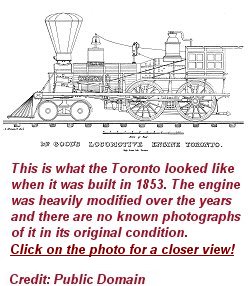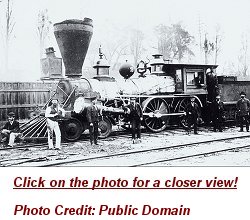
In 1853, the Toronto Locomotive Works built the first steam locomotive manufactured in Canada. Before then, locomotives had been imported from Great Britain or the United States. The TLW was owned by James Good, an Irish immigrant who established a foundry in Toronto in 1840 to manufacture stoves, kettles, plows, boilers and stationary steam engines. By 1852, Good’s Toronto Locomotive Works employed over a hundred craftsmen and was located in a sprawling complex on the northeast corner of Queen and Yonge Streets, approximately where St. Michael’s Hospital and the Elgin-Winter Garden Theatre are located today.
The new locomotive was completed on Saturday, April 16, 1853. Without the tender, the engine weighed 29 tons and was 26 feet in length. While small by later railway standards, the engine was considered at the time to be of monstrous proportions. The OS&H named the locomotive Toronto and it was displayed to an admiring public on Queen Street for two days. Former Toronto mayor and political firebrand William Lyon Mackenzie wrote admiringly about the engine, calling it, “Truly a beautiful piece of machinery very strong and handsomely finished.”
Good now faced the problem of moving the locomotive down to Front Street where the closest OS&H tracks were located. Temporary tracks were laid west on Queen St. and south on York St. The locomotive was slowly moved with crowbars a few inches at a time and the tracks behind the Toronto were then taken up and relaid in front of the engine. This laborious process took five days and the engine arrived at the railhead on April 26. The Toronto’s tender was moved separately on a horse-drawn float.
The Toronto Locomotive Works built a total of 23 steam locomotives, including nine for the OS&H and eight for the Grand Trunk Railway. The operation was always hindered by the cumbersome distance between the foundry and the railway tracks. Good attempted to move the works closer to the waterfront but the city would not cooperate, possibly because some influential city politicians had financial interests in rival manufacturers. Good stopped building locomotives altogether in 1859 and focused entirely on manufacturing stoves and other domestic iron products.
The Toronto was scrapped in 1881 and none of Good’s locomotives survived into the 20th century. The last remnants of the Toronto Locomotive Works disappeared in 1909, the same year the present Bank of Montreal structure was built on the corner of Queen and Yonge Streets.
The locomotive Toronto was commemorated in a Canada Post stamp issued in 1983 and a $20 silver coin issued by the Canadian Mint in 2000.
Written by Derek Boles, TRHA Historian, who retains copyright on the content. These pages are not to be reproduced without written permission.


